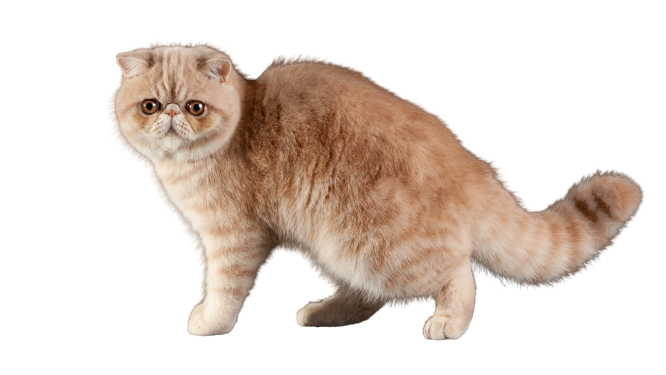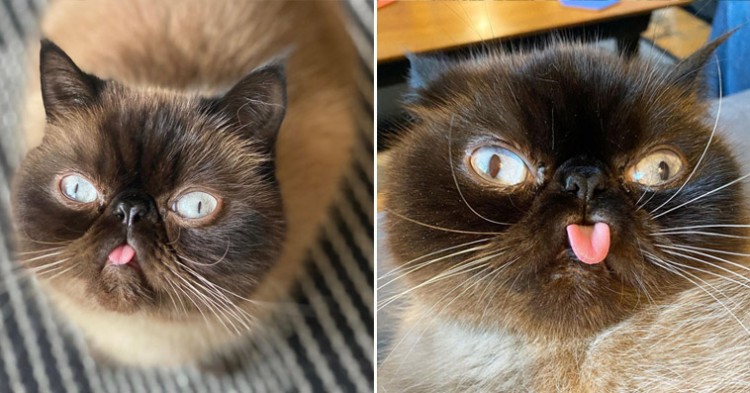
Exotic Shorthair
USD $1200 - $2200 Price Avg.
Medium
Size
Yes
Lap Cat
12 to 15 years
Lifespan
Breed Information
| Popularity/Rank | 2 |
|---|---|
| Name | Exotic Shorthair |
| Other names | Exotic |
| Origin | United States |
| Size | Medium |
| Coat | Plush, Shorthair, Soft, Dense |
| Lap Cat | Yes |
| Lifespan | 12 to 15 years |
| Temperament |
Loyal, Peaceful, Quiet, Sweet, Affectionate Loyal: The Exotic Shorthair is a loyal breed of cat, often remaining close to its owner and forming strong bonds. They are known for being peaceful and quiet, making them ideal companions for those looking for a calm pet. They are also sweet and affectionate, often enjoying cuddles and attention from their owners. |
| Weight | 8 to 14 pounds |
| Colors | ..., All patterns & Colors, Blue, Chinchilla, Chocolate, Cream, Lilac, Red, Shaded Silver, Silver, White, Black |
| Kitten Prices |
USD $1200 - $2200
An Exotic Shorthair kitten can cost anywhere from USD $1200 to $2200. The price of an Exotic Shorthair kitten depends on the breeder and their reputation. Some breeders may charge more for their kittens if they have a good reputation, while others may charge less. The price also depends on the quality of the kitten. A higher quality kitten will usually cost more than a lower quality kitten. When choosing an Exotic Shorthair kitten, it is important to consider the price and the quality of the kitten before making a decision. |
Breed Characteristics
| Adaptability | |
|---|---|
| Affection Level | |
| Child Friendly | |
| Dog Friendly | |
| Energy Level | |
| Grooming | |
| Health Issues |
heart disease, respiratory problems, kidney disease Is Exotic Shorthair cat Hypoallergenic? The Exotic Shorthair is a hypoallergenic cat breed, meaning that they are less likely to cause an allergic reaction in people with allergies to cats. They are a relatively new breed, having been developed in the 1960s in the United States. The Exotic Shorthair is a cross between the Persian and the American Shorthair. They have a short, dense coat that is easy to care for and does not shed much. 1. Heart Disease Exotic Shorthair cats are prone to heart disease. This is a serious condition that can lead to death. If you have an Exotic Shorthair cat, it is important to take them to the vet for regular checkups and to watch for signs of heart disease. 2. Respiratory Problems Exotic Shorthair cats are also prone to respiratory problems. This is due to their short noses. If you have an Exotic Shorthair cat, it is important to take them to the vet for regular checkups and to watch for signs of respiratory problems. 3. Kidney Disease Exotic Shorthair cats are also prone to kidney disease. This is a serious condition that can lead to death. If you have an Exotic Shorthair cat, it is important to take them to the vet for regular checkups and to watch for signs of kidney disease. |
| Intelligence | |
| Shedding | |
| Social Needs | |
| Stranger Friendly | |
| Vocalization | |
| Health Care |
The Exotic Shorthair is a relatively healthy breed of cat, but like all breeds, they are susceptible to certain health conditions. Some of the more common health problems seen in Exotic Shorthairs include heart disease, respiratory problems, and kidney disease.
Heart disease is the most common health problem seen in Exotic Shorthairs. The most common type of heart disease seen in this breed is cardiomyopathy, which is a disease of the heart muscle. Cardiomyopathy can lead to heart failure and death. Respiratory problems are also common in Exotic Shorthairs. The most common respiratory problem seen in this breed is asthma. Asthma is a chronic condition that can be very serious. It is important for owners of Exotic Shorthairs to be aware of the signs of asthma and to seek veterinary care if their cat shows any signs of the disease. Kidney disease is another common health problem in Exotic Shorthairs. Kidney disease can be caused by a number of different things, including infection, inflammation, and genetics. Kidney disease can be very serious and can lead to death. |
History
The Exotic Shorthair is a relatively new breed of cat, having only been around since the 1960s. Despite their short history, they have already had a tumultuous journey that has seen them come close to extinction and then become one of the most popular breeds of cat in the world.
The Exotic Shorthair was created by crossing Persian cats with American Shorthairs. The goal was to create a cat that had the best features of both breeds - the long, thick coat of the Persian and the muscular body and short coat of the American Shorthair. The first generation of Exotic Shorthairs were born in 1966 and were immediately popular, with people eager to get their hands on one of these new "designer" cats.
However, just a few years later, the popularity of the Exotic Shorthair began to decline. This was due to a number of factors, including the high cost of buying one and the fact that they required more grooming than other breeds of cat. As a result, many Exotic Shorthairs were abandoned or given up to animal shelters, and by the early 1980s it is estimated that there were only around 200 left in existence.
Thankfully, things began to turn around for the breed in the mid-1980s when a group of dedicated breeders decided to try and save them from extinction. They began a breeding program which slowly but surely increased the numbers of Exotic Shorthairs until they were once again widely available. Today, they are one of the most popular breeds in America and Europe, with people drawn to their beautiful coats and gentle personalities.
The Exotic Shorthair is recognized as a distinct breed by all major cat registries, including The International Cat Association (TICA), The Cat Fanciers Association (CFA), and The Governing Council of Cat Fancy (GCCF).
Description
The Exotic Shorthair is a relatively new breed of cat, having been developed in the 1960s as a cross between the Persian and the American Shorthair. The Exotic has since become one of the most popular cat breeds in the world.
Appearance-wise, the Exotic Shorthair is very similar to the Persian, with a short, thick coat and a broad, round face. However, there are some key differences between the two breeds. The Exotic has a shorter nose than the Persian, and its eyes are set further apart. Additionally, its ears are larger in proportion to its head than those of the Persian. The Exotic also has a shorter body and legs than its cousin breed.
When it comes to size, weight, and colors, there is quite a bit of variation within the Exotic Shorthair breed. Males typically weigh between 10 and 15 pounds, while females usually weigh between 8 and 12 pounds. As for colors, black, blue, brown/chocolate, cream/white/beige/buff/golden/red/orange/yellow (including bi-color), silver/gray (including bi-color), and tabby (including bi-color) are all accepted by major cat registries.
The Personality of an Exotic Shorthair is typically sweet-tempered and gentle. They tend to be quiet cats that enjoy spending time curled up on their owner's lap or taking naps in sunny spots around the house. While they may not be as outgoing as some other breeds of cats, they generally do well with other pets in the home and get along fine with children and adults alike.
When it comes to health, Exotic Shorthairs are generally considered to be a healthy breed with few major health concerns. However, like all cats, they are susceptible to certain health conditions such as obesity (due to their love of food!), heart disease, respiratory problems (due to their short noses), kidney disease, bladder stones, and diabetes. It is important to work with your veterinarian to ensure that your Exotic stays healthy throughout its life.
The Adaptability level of an Exotic Shorthair is generally high; they do well in both small apartments and large homes alike. They also tend to do well when left alone for periods of time (such as when their owners are at work) as long as they have plenty of toys and activities to keep them occupied during those times. Additionally, they typically get along well with other pets in the home (such as dogs or other cats) provided that introductions are done slowly and carefully.
Exotic Shorthair Posts
Explore Exotic Shorthair's photos, videos, activities, stories, and facts.




